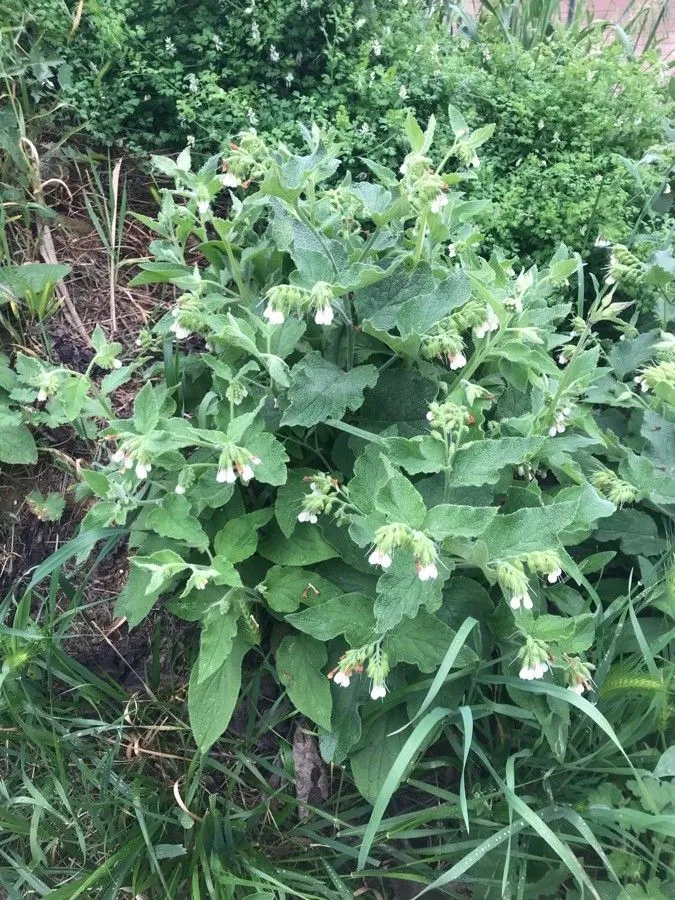
Author: L.
Bibliography: Sp. Pl.: 136 (1753)
Year: 1753
Status: accepted
Rank: species
Genus: Symphytum
Vegetable: False
Observations: SE. Bulgaria to W. Türkiye, Ukraine to Caucasus
White comfrey, scientifically known as Symphytum orientale, is a noteworthy member of the Boraginaceae family, which boasts a variety of flowering plants. Initially described by the esteemed botanist Carl Linnaeus in 1753 in his work “Species Plantarum” (Sp. Pl.: 136), this perennial herb has captivated botanists and gardeners alike for centuries.
Native to a broad swath of southeastern Europe and western Asia, white comfrey thrives in countries ranging from southeastern Bulgaria to western Turkey, extending its reach northward into Ukraine and eastward to the Caucasus region. This geographical spread illustrates the plant’s adaptability to different climates and terrains, emphasizing its resilience and ecological versatility.
The plant itself is easily recognizable by its distinctive white, bell-shaped flowers that bloom in clusters, typically during the late spring and early summer. The foliage of white comfrey is equally notable, characterized by its large, rough-textured leaves that provide a lush ground cover. These leaves are not only visually appealing but also serve functional purposes in traditional medicine and gardening.
In traditional herbal practices, white comfrey has been utilized for its purported medicinal properties, particularly in aiding wound healing and reducing inflammation. However, modern usage often requires caution due to the presence of certain compounds that can be toxic in large quantities or with prolonged use.
Gardening enthusiasts appreciate white comfrey for its hardy nature and its role as an effective ground cover, helping to suppress weeds and enrich the soil with organic matter as its leaves decompose. Moreover, it can enhance garden biodiversity by attracting pollinators, such as bees, with its nectar-rich flowers.
In summary, Symphytum orientale, or white comfrey, is a plant of significant botanical interest. Its wide native range, distinctive physical characteristics, and various uses in herbal medicine and gardening contribute to its enduring popularity and scientific relevance.
Ita: consolida orientale
Fra: consoude d’orient
Deu: orientalischer beinwell, weißer beinwell
Dan: orientalsk kulsukker
Eng: white comfrey, eastern comfrey, soft comfrey
Swe: turkisk vallört
Cym: cyfardwf gwyn, cyfardwf wen
En: White comfrey, Eastern Comfrey, Soft Comfrey
Da: Orientalsk kulsukker
Fi: Ruotsinraunioyrtti
Fr: Consoude d’Orient
De: Weißer Beinwell, Orientalischer Beinwell
It: Consolida orientale
Es: Consuelda oriental
Sv: Turkisk vallört
Cy: Cyfardwf wen, Cyfardwf Gwyn
© copyright of the Board of Trustees of the Royal Botanic Gardens, Kew.
Taken May 6, 2022 by Francesco Sabatini (cc-by-sa)
Taken Apr 28, 2021 by Beytullah AYDIN (cc-by-sa)
Taken Mar 31, 2022 by John Hunston (cc-by-sa)
Taken Mar 24, 2020 by Marie-Claude Deboin (cc-by-sa)
Taken Mar 24, 2020 by Marie-Claude Deboin (cc-by-sa)
Taken Jan 1, 1800 by Tela Botanica − Thierry Pernot (cc-by-sa)
Taken Apr 2, 2022 by Sylvain Piry (cc-by-sa)
Taken Sep 18, 2022 by Diego Alex (cc-by-sa)
Taken Jun 16, 2020 by Frozy
Taken Jun 6, 2020 by Selim E. (cc-by-sa)
Taken Oct 29, 2022 by Peg Somsen (cc-by-sa)
Taken Apr 29, 2021 by Nicola sutherland (cc-by-sa)
Taken Jun 7, 2022 by John Shelley (cc-by-sa)
Taken Mar 24, 2020 by Marie-Claude Deboin (cc-by-sa)
Taken Apr 21, 2021 by Denis Bastianelli (cc-by-sa)
Taken Jun 16, 2020 by Frozy
Taken Apr 23, 2021 by David Hocken (cc-by-sa)
Taken Apr 26, 2021 by yisus (cc-by-sa)
Taken Mar 24, 2020 by Marie-Claude Deboin (cc-by-sa)
Taken May 26, 2021 by Marie-Claude Deboin (cc-by-sa)
Taken Jun 17, 2022 by Laurent Sultana (cc-by-sa)
Taken Jun 11, 2021 by Makarov Valeriy (cc-by-sa)
Taken Jan 1, 1970 by Photoflora – L’Abbé COSTE (©)
Taken Sep 23, 2013 by Tela Botanica − jean-claude echardour (cc-by-sa)
Taken May 12, 2012 by Tela Botanica − John DE VOS (cc-by-sa)
Taken May 12, 2012 by Tela Botanica − John DE VOS (cc-by-sa)
Ph maximum: 8.0
Ph minimum: 7.5
Light: 8
Atmospheric humidity: 7
Bloom months: [‘may’]
Soil nutriments: 7
Family: Myrtaceae Author: (F.Muell.) K.D.Hill & L.A.S.Johnson Bibliography: Telopea 6: 402 (1995) Year: 1995 Status:…
Family: Rubiaceae Author: Pierre ex A.Froehner Bibliography: Notizbl. Bot. Gart. Berlin-Dahlem 1: 237 (1897) Year:…
Family: Sapindaceae Author: Koidz. Bibliography: J. Coll. Sci. Imp. Univ. Tokyo 32(1): 38 (1911) Year:…
Family: Asteraceae Author: A.Gray Bibliography: Pacif. Railr. Rep.: 107 (1857) Year: 1857 Status: accepted Rank:…
Family: Fabaceae Author: Medik. Bibliography: Vorles. Churpfälz. Phys.-Ökon. Ges. 2: 398 (1787) Year: 1787 Status:…
Family: Aspleniaceae Author: (Cav.) Alston Bibliography: Bull. Misc. Inform. Kew 1932: 309 (1932) Year: 1932…